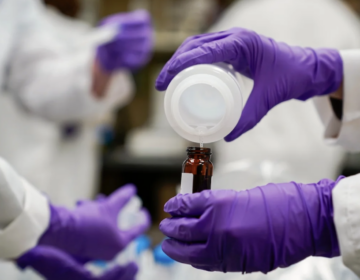Pennsylvania residents, firefighters support legislation to ban toxic firefighting foam
Firefighting foam containing toxic PFAS chemicals has contaminated drinking water supplies across the U.S.
Listen 2:29
File - Firefighters spray fire suppressant foam to douse flames on a tanker truck in a simulated oil-spill fire during a drill on Wednesday, May 7, 2014, in Albany, N.Y. (AP Photo/Mike Groll)
This story is part of the WHYY News Climate Desk, bringing you news and solutions for our changing region.
From the Poconos to the Jersey Shore to the mouth of the Delaware Bay, what do you want to know about climate change? What would you like us to cover? Get in touch.
For about 20 years, Julie Cassidy drank the water from the tap at her home in Warminster, Pennsylvania, unaware that she was ingesting toxic PFAS chemicals that are now linked to serious health problems.
For decades, firefighting foam containing the so-called “forever chemicals” was discharged at the former Naval Air Warfare Center, a couple of miles from her house, and made its way to nearby drinking water supplies.
Surrounding areas were also contaminated with PFAS, like drinking water supplies in nearby Horsham, because of the use of firefighting foam at other military bases.
On Cassidy’s small street of about 10 homes, neighbors were diagnosed with brain tumors and cancers over the years. In 2017, her husband died after a battle with leukemia cutis, but physicians couldn’t prove the exact cause.
A few years later, Cassidy learned about the tainted water. Today, she’s one of several area residents who have higher-than-average levels of PFAS in their bloodstream.
“It was the hidden secret within the community that nobody was told that these chemicals could have affected us or could have hurt us, and that they’re never going away,” she said.
Though Cassidy has since moved out of the area to Gilbertsville, she continues to drink bottled water, unable to trust public drinking water.
Push to ban PFAS
Pennsylvania lawmakers hope to reduce PFAS exposure by banning firefighting foam that contains the chemicals. The legislation, sponsored by state Rep. Brian Munroe, D-Bucks, would ban the manufacture, sale and distribution of the foam starting July 1, 2026, and ban its use one year later. The House unanimously passed the bill last month, and it now awaits a vote in the Senate.
PFAS, widely used in consumer products such as nonstick cookware and waterproof clothing, have been linked to serious health problems, including some cancers, thyroid disease, developmental delays in children and other health conditions.
The chemicals are also found in the foams used to put out fires. Aqueous film forming foam, or AFFF, is one of the most effective fire-suppressing foams because it not only smothers fires but is also fuel-resistant.
Primarily used for extinguishing liquid fuel fires, AFFF has been most frequently discharged at military bases and airports during practice drills and emergencies such as aircraft fires — contaminating drinking water supplies across the Philadelphia region and the U.S.
Dustin Grow was stationed at the Willow Grove Air Reserve Station in Horsham between 2002 and 2011. In addition to using AFFF during emergencies and practice drills, he was required to test the potency of the toxic foam every year.
Aircraft hangar systems also automatically discharged foam if a fire was detected — even during false alarms. Accidental discharges at hangars have been common nationwide, causing concern for the environment.
Grow said he was frequently required to walk through knee-high and waist-high foam, shut the system off and help wash the foam down the drain.
“At the time, you didn’t really know about PFAS or anything like that, so you just thought it was basically a form of soapy water,” Grow said. “You didn’t really think there was any kind of real crazy harmful chemicals in it.”
In 2014, PFAS chemicals were found in Horsham’s drinking water supplies.
James Boyle, a battalion chief from Lower Macungie, has been stationed at Air Force bases nationwide. He recalls AFFF foam was used somewhat indiscriminately when he started his career in the early 2000s.
“At my first duty station, it was almost like a rite of passage to get sprayed down with foam. It was not uncommon to spray people, because it looks like bath bubbles. There was really no known cancer hazard at the time,” he said. “[The foam] would get coagulated, kind of clumpy, and so we would end up just pouring it down the drain to get rid of it, which wasn’t good.”
Municipal firefighters also commonly used and practiced with the product.

“For years and years, we trained with it,” said Travis Temarantz, a firefighter in Wilkes-Barre who has advocated for toxin-free equipment. “You went out, you were covered in it, regardless of in your gear or not, and you had it on your hands, it was on your face, the wind would blow back, you would be breathing it in.”
In addition to protecting drinking water supplies, the new legislation also aims to protect firefighters — cancer is the top cause of line-of-duty deaths among firefighters, and exposure to PFAS increases their risk.
PFAS can stay in the environment — and the human bloodstream — for years. Nearly 40 years after AFFF was used to put out a tire fire in Sellersville, Bucks County in 1986, local wells remain contaminated with toxic PFAS.
“When you spray these onto surfaces, they’re able to easily migrate through the environment, down into the soil or into the water streams, and that creates an environmental hazard,” said Brian Lattimer, a mechanical engineering professor at Virginia Tech who researches fires.
For this reason, the U.S. Department of Defense has already begun phasing out AFFF, and 15 states have banned its usage. The U.S. Environmental Protection Agency also implemented regulations last year requiring water providers to test and treat “forever chemicals” to almost zero, but has since proposed to weaken some of the rules.
Finding a replacement
Several PFAS-free firefighting foams are available, but some are not compatible with existing equipment. They’re also not as effective, Lattimer said.
“There’s no real drop-in replacement for AFFF,” said Lattimer, who is part of a research team developing AI tools and test methods to help chemists identify alternatives that are as effective as AFFF.
Several fire companies across the state have begun to transition away from AFFF, said Scott Little, vice president of the Pennsylvania Career Fire Chiefs Association. Little is the Fire Chief for the Manheim Township Fire Rescue in Lancaster County, which received a grant in 2023 to switch to PFAS-free foam.
He said that because they’re somewhat less effective, emergency responders must apply more foam to extinguish fires. Little said it’s a change firefighters are willing to make if it means protecting emergency responders and drinking water supplies.
“I think we’re doing the right thing by this transition and getting everybody to recognize the need to make sure that our communities are safe, and we also are mindful of our impact on the environment,” he said.
The new legislation would also require warning labels on firefighters’ gear containing PFAS, which makes the products more resistant to water, heat and oil.
Temarantz said he and his colleagues are anxious about their exposure to “forever chemicals” and worry they may have unknowingly exposed their loved ones.
“I have a car, I throw my gear in the back seat of the car and then I work my shift, I come home and what do I do? I take my daughter, my girlfriend, for dinner and they’re in the vehicle with me. Now they’re exposed because that all transfers to my car,” Temarantz said.
“You might have gone to a training class, used the foam … never showering, not realizing what you’ve had on you. You’re taking it home, you’re taking your clothes off, you throw them in the hamper with the rest of your family’s clothes.”
A separate bill, sponsored by state Rep. Patrick Harkins, would prohibit the distribution, manufacture, production or sale of firefighting personal equipment that contains an intentionally added PFAS chemical.
“Something that we actually thought was out there protecting us is actually harming us in the long run,” Temarantz said. “We deserve to have a set of gear that is not going to poison us, that’s not going to give us those health problems.”

Get daily updates from WHYY News!
WHYY is your source for fact-based, in-depth journalism and information. As a nonprofit organization, we rely on financial support from readers like you. Please give today.






